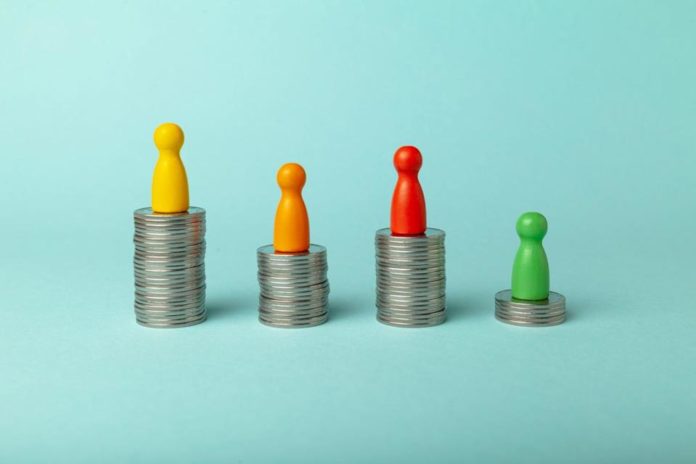
Getty Images.
The Supreme Court’s recognition of same-sex marriage in 2016 impacted a number of LGBTQ+ families. After all, the social institution of marriage works to empower LGBTQ+ parental rights by creating legal ties between partnered queer parents and their children. Following this ruling, married same-sex couples gained financial benefits previously reserved for opposite-sex couples-from health insurance to spousal support to the ability to file joint tax returns. But gay marriage equality can only do so much when a wage gap persists for LGBTQ+ earners-many of whom are parents.
According to the UCLA LGBT Demographic Data Interactive, although only 9% of the LGBTQ+ community were unemployed in 2019, 15% of them were uninsured, 25% had income under the poverty threshold for a family of four ($24K), and 27% experienced food poverty.
RELATED: The LGBTQ Community’s Struggle for Paid Parental Leave is Real
The wage gap breakdown
According to research from Prudential Financial: The LGBT Financial Experience, 2016-2017, on average, bisexual men earned $85,084 per year, heterosexual men earned $83,469, gay men earned $56,936, heterosexual women earned $51,461, lesbian women earned $45,606 and bisexual women earned $35,980. (Data on non-binary, transitioning, or genderqueer peoples’ earnings are scarce, but hopefully the next Census will change this).
Plus, the usual gender and race income gaps remain within the LGBTQ+ community, with women earning less than men, and Black women earning less than white women. The National Black Coalition for Justice (NBCJ) also found that gay and bisexual men, the highest earners of the LGBTQ+ community, do experience a wage penalty, earning 10%-32% less than heterosexual men (when studies were controlled for education, occupation, and location).
Bisexual men earned $85,084 per year, heterosexual men earned $83,469, gay men earned $56,936, heterosexual women earned $51,461, lesbian women earned $45,606 and bisexual women earned $35,980.
Why does sexual orientation affect wages?
According to Trenton D. Mize, sociology professor at Purdue University, someone’s sexual orientation could be a “hidden and unobservable characteristic to employers with an unconscious bias towards observable cues”-that ultimately makes an employer low-ball that person’s salary ask. Just being single can reduce income-an effective marriage-and-parent premium that also impacts men and women differently.
The National Transgender Discrimination Study found that 78% of transgender and gender-nonconforming employees had experienced harassment or discrimination at work. That survey also found that although transgender workers were more highly educated than cisgendered workers, their unemployment rate was double that of the general population-and 25% of trans folks had been fired because of their gender identity.
Mize found that LGBTQ+ people also face assumptions of lower competence. Sexual orientation remains an unprotected status in most states; no federal law prohibits discrimination in the workplace on this basis. However, further to Bostock v. Clayton County, the proposed Equality Act (H.R. 5/S. 393) would amend the 1964 Civil Rights Act-thus making discrimination based on sex/sexual orientation unlawful.
RELATED: The ‘Motherhood Penalty’ is Real and It Robs Moms of Career Advancement
How pay disparities affect LGBTQ+ families
According to the latest census data, there were 543,000 same-sex married couple households in 2019, 469,000 same-sex unmarried partner households, and 191,000 children living with same-sex parents.
The Prudential study found that LGBTQ+ respondents were creative when trying to save for retirement, life and health insurance, and estate planning-yet many are thwarted by both policy and discrimination. They are concerned about employment protection for partners, inflation, unpaid debt, wage inequality, job insecurity, and pension survivor benefits. The pandemic and a stagnant economy compound this: Mid-pandemic, 41% of LGBTQ+ respondents felt they were struggling financially, particularly millennials and generation X. Meanwhile, 25% of LGBTQ+ millennial respondents were unemployed or experienced long-term leave.
Also according to Prudential, LGBTQ+ respondents owned fewer retirement accounts-despite comparable access to workplace plans. Only half of them had a checking, savings, or money market account, or certificates of deposit.
What makes queer family life more costly?
To start a family, many in the LGBTQ+ community choose to pay for IVF treatment or pursue a costly surrogacy (or two). LGBTQ+ parents may struggle to obtain Assisted Reproductive Technology coverage, as it is typically for people diagnosed with infertility. Despite the Affordable Care Act, employee benefits such as insurance are not available for all. In addition, second-parent adoption is the only option for many queer couples starting a family.
RELATED: Is the Extreme Cost of IVF in America Really Necessary?
Jasmine Higgins, co-host of podcast Infertilidad Latina, explains to Parents that “LGBTQ+ individuals and couples face disproportionate financial burdens. In our experience, when we put our home on the market-we knew our home’s worth, and were offered significantly lower by a few realtors, because we were an interracial lesbian couple. We sought another opinion via Zoom, where we did not show our faces, and the value was increased by $175K. The only difference was hiding our identities-and somehow the offer changed.”
Higgins adds that “LGBTQ+ families also have family-building expenses to save for-be it IVF, surrogacy, or adoption. Insurance and employers rarely cover these expenses, and it therefore puts most LGBTQ+ couples in a financial strain trying to start a family. From lower property value estimates [to] lack of coverage for family building, I believe LGBTQ+ families are hindered from saving for retirement and managing to thrive when the odds of fair treatment and health coverage limit our ability to save for the future.”
We knew our home’s worth, and we were offered significantly lower…because we were an interracial lesbian couple. We sought another opinion via Zoom, where we did not show our faces, and the value was increased by $175K. The only difference was hiding our identities.
The 2021 FertilityIQ Workplace Index revealed an 8% growth among large employers that introduced or enhanced fertility, adoption, or fostering benefits. However, a number of companies made reductions to their coverage of more costly approaches, such as surrogacy, which benefits a great many in the LGBTQ+ community. Adoption assistance, similarly, dramatically trailed fertility assistance-and LGBTQ+ employees were the most impacted.
The Debt-Free Guys (John Schneider and David Auten) run a financial advice blog and the and Queer Money podcast, which targets the gay community. Schneider tells Parents that he advises queer folks “to keep our debt levels low, have emergency savings, live by a budget, save and invest. The more savings and investments we have…the more flexibility we have to leave an employer or industry that won’t pay or treat us fairly.”
“It’s true that creating this flexibility is harder when we’re paid less,” Schneider adds. “But it’s also true that it’s not always about how much we earn-but how we use what we earn. We know LGBTQ folks who earn $40,000 a year and have more in retirement savings and have traveled the world, and those who have multiple six-figure incomes with tens of thousands in debt living paycheck-to-paycheck.”
More actionable advice from Schneider, for queer families? “In the workplace, join or create an LGBTQ employer business group to help your business connect with the LGBTQ community and to push the concerns of LGBTQ employees, including pay discrimination, up the chain of command,” he urges. “Likewise, join leadership organizations, such as OutLeadership, that are trying to put more LGBTQ people in C- and E-Suites-because in time, we can make the sexual orientation and gender identity pay gap go away.”
Why are bisexual women bearing the brunt, financially?
A 2018 Buzzfeed survey found that bisexual men and women outnumber gay men and lesbian women in the U.S. (46% of the LGBTQ+ community identify as bisexual, 32% as gay, 16% as lesbian, 1% as asexual, 1% as straight, and 1% as queer or otherwise self-describing). But until recently, wage discrimination against bisexual women in particular has been conflated with discrimination against gay women. In 2016, Mize’s research uncovered that bisexual women earned between 9% and 17% less less than heterosexual women-according to his study published in the American Sociological Review.
“It’s not any of the traditional suspects, like differences in educational credentials, occupational selection, or anything else,” Mize explains. Simply, “bisexual women are reporting that others treat them with less respect-and other indicators that suggest they are being stigmatized. In other work of mine, I have shown that bisexual people face uniquely disadvantaging stereotypes-so these reports of feeling stigmatized correspond closely with the stereotypes people have of the group.”
“I have done some unpublished analyses of more recent data, and the findings are the same… I see no evidence in the data yet that the bisexual wage gap has narrowed,” he adds.
What’s the way forward?
As Mize mentions, cultural attitudes are changing. A 2019 Gallup Poll found that 93% of people think that gay and lesbian people should have equal rights in terms of job opportunities; for bisexual, transgender, and gender non-conforming folks, it may be a longer battle. A 2019 Gallup Poll also found that 53% of people thought new civil rights laws were needed to reduce discrimination against lesbian, gay, bisexual, and transgender people.
Thankfully, it seems that more and more individuals-as well as institutions and initiatives such as Equal Pay Day-are supportive of the changes that are needed to eliminate the LGBTQ+ wage gap.
Even Mize, with all his damning research and knowledge, is not without hope. “I think we will see progress as younger generations age into the labor market-and particularly into management roles,” he says. “Prejudicial attitudes toward sexual minorities…are markedly lower among younger generations. So, I strongly suspect the trend over the long-term will be towards more equality of labor market outcomes.”








